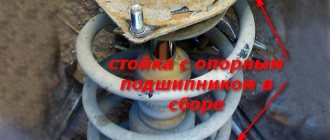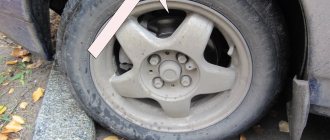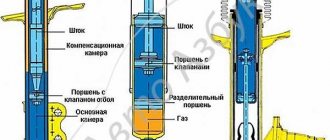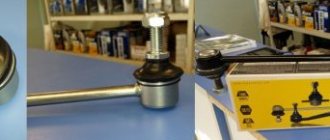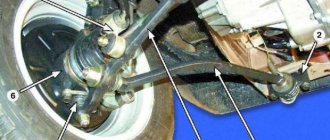Why did the new shock absorber leak?
There are times when you buy new shock absorbers for your car, come to a service station, they remove the old shock absorbers on your car and install new ones.
Together with them they install a new service kit (boots and shock absorber bumpers), and you drive away in your car with new shock absorbers installed. With the old shock absorbers, you felt that the car was somehow “sluggish” and “shaky.” I didn’t keep the road on a “washboard”, the extraneous knock on a not entirely smooth road (which in our city, and not only in our city, is about 99%) was just “sick”... You stopped at a service station. This service station was recommended to you by your good friends - they get their car repaired here. True, your car is a different brand than your friends. But, according to most car owners, the cars are the same. They (cars) all have four wheels, the wheels are round, and all cars are controlled by a steering wheel.
So, after installing new shock absorbers,
– we immediately felt the difference in driving. Everything became different. And immediately your car became somehow “knocked down”. Something in it has stopped annoyingly knocking, as they explained to you - this knocking was caused by wear of the shock absorber rod in the “working comfort zone”. This doesn't tell you much. You are happy with the result: although the shock absorbers are not cheap, the result is obvious.
But... After some 20-30 kilometers, it began to seem to you that the car began to “knock” again and stopped holding the road, returning to its condition, which was before replacing the shock absorbers and bumper guards. You begin to think that the reason is that you bought non-original shock absorbers. “Maybe I should have put on the original?” – you begin to think.
The next day, you come to the service station where your shock absorbers were changed. Tell us your thoughts about original and non-original shock absorbers. They listen to you carefully, say: “Perhaps,” and drive the car onto a lift for diagnostics.
When you lift the car, the defect immediately becomes obvious! Both shock absorbers leaked... There was some kind of smile on the faces of the mechanics. But this smile gives way to an incomprehensible grimace of bashful horror when they remove the shock absorber from the car and expose the shock absorber rod, removing the bumper boot from it... The shock absorber rod has traces of scuffing. Moreover, these scuffs on the rod are not longitudinal (in the direction of shock absorber operation), but transverse. It’s as if someone specially took and “pulled” the rod with some kind of tool, but it’s not clear why?!
Later it turns out that the careless mechanic who changed the shock absorbers had no idea how shock absorbers are changed correctly, as described in the technical literature. Later, of course, the owner of the service station will be forced to apologize to you and eliminate the defects in the work performed by his employee - at the expense of the service station. You no longer care about the fate of that careless mechanic; you want to leave the service station faster with a repaired car.
What can we advise to avoid getting into such situations? Defects at work and careless employees are found in many areas of human activity. “He who does nothing makes no mistakes,” the proverb tells us.
But, still: trust the repair of your car only to professionals. Buy spare parts only in a car store that you have verified and where you liked both the level at which you were served and the professionalism of the employees.
Share link to:
List of articles »
m. Kharkiv Telephone: +380(67) 57-19-19-7 +380(57) 716-42-44
Why did the shock absorber leak?
From a technical point of view, a shock absorber is perhaps one of the key parts of a car’s suspension. If all other components of the chassis are diagnosed simply, using installation, then a full diagnosis of the shock absorber should be carried out only on a special stand. Despite this, the level of shock absorber production today is so high that the percentage of defects in the final product does not exceed 0.5%. So why do shock absorbers leak? Sellers have a firm and unambiguous answer to this: the cause of hydraulic fluid leaks in the winter season is primarily due to improper operation.
“The comfortable operating temperature range for hydraulic (gas-oil) shock absorbers is from -25°C to +30°C. In this range, shock absorbers operate without significant overloads, but this does not mean that they are not designed to work in a lower range, says Sales Director Maxim Legushev. — I know that Sachs shock absorbers are tested at the factory at an air temperature of -43°C. And even in such difficult conditions they demonstrate excellent performance. It is only important to follow the operating rules."
Warming up the suspension
As a matter of fact, there is only one rule for using shock absorbers in cold weather - they must be given the opportunity to warm up in a gentle operating mode. The engine can be warmed up before driving, but the chassis cannot. Accordingly, it needs to be warmed up in the first minutes of movement.
“Warming up the shock absorber means that after parking in the cold, you should start moving slowly and carefully, avoiding holes and obstacles, so that the amplitude of vibration of the shock absorber rod is minimal. In this mode, the hydraulic fluid will gradually reach operating viscosity and temperature. The likelihood of damage to the shock absorber and leakage of hydraulic fluid from the shock absorber will be minimized,” explains KYB brand manager Evgeniy Lyakhovich. “Every motorist must decide for himself how much time to spend warming up the suspension, based on the ambient temperature, the length of time the car is parked and a subjective assessment of the suspension’s performance.”
Maxim Legushev adds that any more or less experienced motorist understands perfectly well when the shock absorbers have already warmed up:
“The car begins to smoothly handle all the bumps, the suspension becomes softer and operates quieter. Everyone knows this, but apparently, in a hurry, many do not give the shock absorbers a chance to warm up and end up with a problem such as a hydraulic fluid leak.”
Not every leak is dangerous
The mechanics of the process are as follows. When exposed to low temperatures, hydraulic fluid thickens and is less easily pumped through the valves. If you force the shock absorber to compress strongly at this moment, then some of the liquid simply will not be able to pass through the channel and be squeezed out through the shock absorber seal.
“However, not every leak of hydraulic fluid from a shock absorber is critical for its performance. Small leaks of liquid through the seal or sweating in the area of the rod do not always lead to a deterioration in the performance of the shock absorber. Most likely, after this the shock absorber will damp normally and dampen body vibrations,” notes car service manager Viktor Volodyushkin.
It will be useful: How to paint a bumper with your own hands?
In general, when designing shock absorbers, the manufacturer takes into account the likelihood that over time the amount of liquid in the chamber will decrease.
“This is done on purpose, since the hydraulic fluid is one way or another gradually consumed to lubricate the rod. A slight fluid leak will not affect the car's handling in any way. The quality of handling all road irregularities will also remain quite high,” confirms Maxim Legushev.
According to Viktor Volodyushkin, hydraulic fluid leakage becomes critical only after inert gas leaves the shock absorber, which serves as additional support and prevents foaming of the fluid when passing minor road irregularities. Such damage to the strut immediately becomes noticeable when moving. The car begins to sway violently, it takes more time to dampen vibrations, and road traction deteriorates.
Who will give the guarantee?
Determining a warranty case is the task of the service station that installs the shock absorbers.
“As you know, under the KYB service program, authorized service centers are required to carefully check the condition of the suspension when installing shock absorbers. The technician decides what the warranty period will be. The maximum warranty period is two years or 70,000 km. If the shock absorber fails during this period, then the service station where the installation was carried out is required to identify the cause. If the cause of the defect is a manufacturing defect, the shock absorber will be replaced with a new one, explains Evgeniy Lyakhovich. — True, if a motorist with a frozen car at -30°C stages a rally on the road without warming up the suspension, then such a case is unlikely to be recognized as a warranty, since the parts of the car’s chassis are simply not designed for this, and the likelihood of damage to the shock absorber in this case is no lower than the chance of tearing anthers and silent blocks.”
How to increase frost resistance?
This question is probably of interest to many Siberians today, who, after the extremely cold January, had to shell out several thousand rubles to replace the racks. Well, if the problem is so acute for you, then you can look on the market for tuning versions of shock absorbers, the design of which uses frost-resistant sealing rings. The vast majority of motorists are confident that the frost resistance of a shock absorber strut depends entirely on the properties of the hydraulic fluid. In fact, the resistance of the shock absorber to frost is largely ensured by the properties of the rod seal.
“I’ll give you a simple example,” says Maxim Legushev. — You drive your frozen car onto the road and immediately end up with a wheel in a hole. Part of the thickened liquid passes through the valve, and the bulk hits the oil seal. If the seal has retained its elasticity in the cold, then it will withstand this blow. If it becomes “stiff,” the liquid will flow out.”
The frost resistance of shock absorber sealing rings from the top five largest manufacturers does not raise any complaints. Some shock absorber manufacturers also produce small series of struts filled with low-viscosity and low-temperature hydraulic fluids. True, large European and Japanese companies do not do this, since the demand for such shock absorbers in the world is extremely low. So you will have to look for such a shock absorber in the model range of Russian manufacturers. In addition, one can only guess what the behavior of such racks will be in the summer, at a temperature of +30°C.
You can also replace the hydraulic fluid in your shock absorber with one that is more resistant to cold weather. True, to do this you will have to completely disassemble the shock absorber, and this is an intervention in its design, which will immediately void your warranty. No manufacturer of shock absorber struts allows them to be disassembled for any purpose.
“The position of shock absorber manufacturers on this issue is adamant. We know that in artisanal conditions, some service stations try to offer such a service, but in this case, the car owner takes all the risks upon himself,” says Evgeniy Lyakhovich.
The same point of view is expressed by other official dealers of shock absorber manufacturing companies. At the same time, experts note that if you installed a leaking shock absorber very recently (less than a year ago), then you can replace only one strut on the car’s axle. But before making such a decision, it is still better to check the condition of the second shock absorber on this axis.
The shock absorber is leaking, what should I do?
Greetings, dear motorists! And again, we continue to study individual systems, components and parts of your car.
Quite a lot of motorists, in particular beginners, believe that the purpose of batteries is only to provide comfort while driving. This is true, but it is just one of the functions. How amazed novice motorists are when they don’t pay attention to leaking shock absorbers, and as a result they end up in a ditch. You wouldn't wish this on anyone!
What to do if the shock absorber starts to creak
One day during a trip, you heard that the rear or front shock absorbers began to creak. This means that it’s time to carry out not only diagnostics of the car’s suspension, but also diagnostics of the shock absorbers. If the shock absorber squeaks, this is a warning for you. When diagnosing the suspension, visually inspect the shock absorbers. If, upon inspection, you find that the shock absorber is leaking, then you should immediately repair or replace it.
Can you guess why? Yes, it’s simple, in the “best” case, only the suspension will suffer, in the worst case, you can become involved in an accident at any moment. How do you like this prospect? If you close your eyes to this, you will spend even more money, not only repairing the shock absorber, but also repairing the suspension. We advise you not to be lazy and visually inspect the shock absorbers systematically. Moreover, there is nothing complicated about it - you turn the wheels and make sure that the shock absorber is not leaking, that everything is normal. Most novice motorists, when diagnosing the condition of shock absorbers, make hasty conclusions about the malfunction of the shock absorbers when they see oil deposits on them. However, there is nothing wrong with this, this is a completely normal condition. But if you notice oil leaks, then replacement or repair certainly cannot be avoided.
Is it possible to drive if the shock absorber is leaking?
A leaking shock absorber is a problem that requires a quick solution. It can lead to other malfunctions. The shock absorber must be replaced as soon as possible, but driving a car with a leaking element is not prohibited if you exercise extreme caution.
When one shock absorber leaks, it is necessary to replace it as quickly as possible so that the problem does not spread to the others. The fact is that the vibrations of the car are distributed between four shock absorbers. If one of them leaks and begins to cope with its assigned tasks worse, then the vibrations will have to be distributed among three shock absorbers, but they are not designed for such a load. Accordingly, if you do not change a leaking shock absorber for a long time, others will soon fail, that is, a massive replacement will be required, which is much more expensive.
When several shock absorbers leak at once, then it is better not to operate the car until they are replaced. If you need to use a car, it is better to choose smoother roads and drive extremely carefully. Without shock absorbers, it is impossible to enter a turn at high speed, and the car can not only skid, but also turn over. In addition, if vibration damping is poor, there is a high risk of damage to other parts of the car.
Article on the topic: Operating principle
Replacing or repairing a shock absorber - the choice is yours
The most common reason that the shock absorber began to leak is the loss of tightness. And all this because the operation of our vehicles takes place practically in combat conditions. However, this does not make it any easier. We need to act immediately. You make the decision whether to repair or replace shock absorbers yourself, relying on the following factors: – it is better to buy a new shock absorber if the cost of repairing and buying a new one is not very different; – provided that you have some skills, you can try to repair the shock absorber yourself using a repair kit.
Video - replacing the shock absorber
Pay attention to this point - most shock absorbers are currently non-separable parts. So, keep in mind that if a car repair shop offers you to restore a shock absorber, then this is a dubious idea, and it is unlikely to be profitable. You are not changing a light bulb, but a part that is responsible for your safety.
Based on practice, we can conclude that a restored shock absorber does not last that long, and then will require repair again. Therefore, if a problem has already emerged - the shock absorber is leaking, it is optimal to replace the shock absorbers. If the shock absorber is restored, it means it will last 5 thousand km, no more, but a new one, taking into account its quality and normal use of the car, will last 5 years, exactly.
Read the Repair and Operation Manual for your car; it should indicate what type of shock absorbers are installed on your car by the manufacturer. If shock absorbers with pumping are installed, then you only need to plug the hydraulic fluid pipes, and that’s all the repairs are. You can repair hydraulic or gas shock absorbers yourself. However, for this you will need special equipment, which you may not have in your garage. In this case, you have a direct route to specialists at a car service center, and this is again a minus in the budget. Practice shows that a leaking shock absorber is best replaced with a new one - this is the only correct solution.
I wish you success! Let such a problem as creaking shock absorbers be familiar to you only in theory!
What are your first steps if the shock absorber is leaking or squeaking?
Good day, dear car enthusiasts! Let's continue to discover the secrets of the purpose of individual components, systems or parts of your car.
Many, especially novice motorists, are convinced that car shock absorbers are intended solely to create comfortable driving conditions for passengers. Yes, naturally, and this is also part of their function.
But imagine the amazement of a novice driver when, without paying attention to the fact that his shock absorbers are leaking, suddenly! ended up in a ditch. God forbid, of course.
What to do if the shock absorber squeaks?
While driving, you hear the shock absorber squeaking in front or behind. Don't brush it off. It's time to diagnose the shock absorbers, and at the same time the car's suspension. The creaking of the shock absorber is a signal to you.
Start diagnosing the suspension with a visual inspection of the shock absorbers. And, if you see that the shock absorber is leaking, then there is no need to put off repairing or replacing it.
Do you know why? Because either you could find yourself involved in an accident at any moment, or the suspension will purposefully and methodically begin to “break.” And this is a plus for shock absorber repair and suspension repair. Plus, of course, in monetary terms.
By the way, don’t be lazy to carry out visual diagnostics of shock absorbers systematically. Moreover, you don’t need to do anything. We turned the wheels and made sure that the shock absorber was not leaking, and everything was in order.
It will be useful: What are the best speakers for a 13 CM car?
When diagnosing the condition of shock absorbers, many novice car enthusiasts make the mistake of thinking that the shock absorber is faulty when they see oil deposits on it. Oil deposits on the shock absorber body are an acceptable phenomenon. But if you see oil leaks, this means that the shock absorber requires repair or replacement.
Important! Experts strongly recommend that replacement of shock absorbers should be carried out in pairs on one axle, even if the second shock absorber is in order and does not show visible signs of malfunction. Shock absorbers, like brake pads or brake discs, are paired parts and therefore require paired replacement.
Repairing or replacing the shock absorber is your choice
The traditional reason for a shock absorber leaking is a loss of tightness. This happens, as a rule, due to the fact that the road operating conditions of the vehicles are close to combat conditions. But this knowledge does not make it any easier for us. A decision needs to be made.
You can make your own conclusion about whether the shock absorber requires repair or replacement, based on the following factors:
- if the cost of repairing a shock absorber is slightly different from the cost of a new one, then, naturally, it is better to buy a new shock absorber;
- If you have certain skills and can repair the shock absorber yourself, you can try restoring it using a repair kit.
Do not forget that most modern shock absorbers are non-separable parts. Therefore, even if you are offered shock absorber restoration at a car service center, then, believe me, this is a dubious benefit and undertaking. After all, you are not changing a light bulb, but a part responsible for traffic safety.
As practice shows, a restored shock absorber does not last long, and then the damping period will begin again. Therefore, if shock absorbers are leaking, then the most optimal solution is to replace the shock absorbers.
A restored shock absorber will last no more than 5 thousand km, and a new one, subject to its quality and normal operation of the car, is guaranteed for 4-5 years.
By looking at the vehicle's Design and Operation Manual, you will see what type of shock absorbers were originally installed on your car by the manufacturer. If these are shock absorbers with pumping, then their repair usually consists of plugging the hydraulic fluid tubes.
To some extent, repairing gas or hydraulic shock absorbers can be done with your own hands. But for this you will need special equipment, which, of course, you don’t happen to have lying around in your garage. This means that you will have to contact a specialist, and this will again be a financial cost.
Practice confirms that if your shock absorber is leaking, then the most correct solution is to replace it with a new one.
Good luck, and don't let the shock absorber squeak bother you for as long as possible.
see also
How to check a support bearing
- 108 1 178k
Strut support bearing
- 76 1 88k
Which shock absorbers are better
- 152 3 141k
How does a car's shock absorber work?
- 4 0 23k
Shock absorber (car shock absorbers)
- 0 0 18k
Shock absorber malfunctions greatly affect the car's behavior on the road. In particular, the car body “dives” during acceleration and braking, the braking distance increases, rolls heavily during maneuvering and sways when driving over uneven surfaces.
There are obvious and hidden signs of faulty shock absorbers. Obvious ones include the appearance of oil leaks (wear of the oil seal and/or rod), but there are more hidden ones, for example, aging of the oil, deformation of the valve mechanism plates, wear of the piston seal and the inner walls of the working cylinder. To avoid unpleasant consequences, you need to identify the faulty shock absorbers in time.
Signs of faulty shock absorbers
There are two types of signs that a shock absorber has completely or partially failed. The first type is visual. In particular, they can be identified by visual inspection of the shock absorber. The second type of signs includes changes in the behavior of the car in motion. Let us first list the signs related to the second type, since first of all it is necessary to pay attention to how the behavior of the machine has changed, in particular:
- Rocking when braking and accelerating . If the shock absorbers are working properly, then even with sharp braking the car should swing back no more than once, after which the shock absorber should dampen the oscillatory movements. If there are two or more swings, this is a symptom of partial or complete failure.
- Roll when maneuvering . Here the situation is similar; after exiting a sharp roll when entering a turn, the body should not sway in the transverse plane. If so, the shock absorber has similarly failed.
- Increased braking distance . This factor is due to the same swing during braking. That is, during prolonged braking, the shock absorber does not dampen vibration, and the car periodically lowers and raises the front part of the body. Because of this, the load on the front wheels is reduced, which reduces braking efficiency. The braking distance is especially longer for vehicles equipped with an anti-lock brake system. This is because the rear end rises and the ABS reduces the brake line pressure. Also, the braking distance increases when braking on uneven roads.
- The car does not “hold” the road . In particular, when the steering wheel is installed in a straight position, the car constantly pulls to the side. Accordingly, the driver must constantly steer in order to align the trajectory of movement.
- Discomfort when driving . It can manifest itself in different ways. In particular, some drivers and/or passengers feel discomfort from the rocking of the car when driving long distances; people suffering from “sea sickness” (the official name is kinetosis or motion sickness) can feel motion sick. This effect is a typical symptom of faulty rear shock absorbers.
What is the effect of a faulty shock absorber?
The use of worn shock absorbers can not only cause discomfort while driving, but also cause a real danger when driving the car. So, possible problems associated with a faulty shock absorber:
- Reduced wheel grip. In particular, when the car rocks, the clutch will have a variable value.
- Increased braking distance, especially on vehicles with an anti-lock braking system (ABS).
- Some electronic systems of the car, such as ABS, ESP (exchange stability system) and others, may not operate correctly.
- Deterioration in vehicle handling, especially when driving at high speed.
- The appearance of “hydroplaning” when driving on a wet road at low speeds.
- When driving at night, constant rocking of the front of the car can cause the headlights to blind oncoming drivers.
- Discomfort when driving. This is especially true when driving long distances. For the driver, this threatens increased fatigue, and for people prone to seasickness, this is dangerous due to motion sickness.
- Increased wear of tires, rubber bushings, silent blocks, bump stops and springs. and other elements of the car suspension.
What are the consequences if you don’t change leaking shock absorbers?
As noted above, failure of shock absorbers will lead to an uneven distribution of load between the remaining functional elements, which will affect their service life for the worse. In this case, the car will begin to seriously rock when driving, which will generally affect driving comfort.
If the driver is not afraid of the car swaying when driving on leaking shock absorbers, we can name a number of problems that a malfunction can lead to:
Impact to the bottom and damage to elements. For example, when overcoming a “speed bump” or a bump, a car on springs may jump and, when moving back, hit the bottom of an obstacle, which will lead to damage;- The occurrence of malfunctions in the suspension. If you drive a car with faulty or missing shock absorbers, over time there will be problems with silent blocks, bushings, ball and other suspension elements that risk failure. This happens because the vibrations of the car will have to be damped by all suspension elements;
- The car will stop “listening to the driver” on the roads. A car with faulty shock absorbers loses a lot in terms of maneuverability and controllability, which can lead to a traffic accident.
As soon as smudges appear on the shock absorber, it needs to be replaced. The part is still capable of working for several days/weeks, but after that it will completely cease to perform its functions.
( 439 votes, average: 4.53 out of 5)
How to remove broken spark plugs yourself
Engine sump drain plug gasket
Related Posts
Causes of shock absorber malfunction
The causes of failure are usually natural factors, including:
- Aging of shock-absorbing fluid (oil). Like other technological fluids in a car, the oil in the shock absorber gradually gains moisture and loses its performance properties. Naturally, this leads to the fact that the shock absorber begins to work harder than it worked before. However, it must be understood that fluid aging does not happen overnight, with the exception of a rupture of the seal on the shock absorber body.
- Torn seal. In particular, the sealing of the piston and the inner walls of the working cylinder. The oil seal can rupture due to external factors or simply due to the aging process. It, like any rubber seal, becomes tanned over time and begins to leak liquid. Because of this, oil leaks from the shock absorber, as well as moisture from the outside entering the oil, which leads to a deterioration in its performance.
- Deformation of the valve mechanism plates. This process is also natural and occurs on an ongoing basis, albeit at different speeds. Thus, the rate of deformation depends on two main factors - the quality of the shock absorber (the quality of the metal of the plates) and the operating conditions of the machine (naturally, a significant impact load leads to premature deformation).
- Gas leak. This is true for gas-filled shock absorbers. The idea here is the same as for oil-filled devices. Gas here performs a damping function, and if it is not there, then the shock absorber will not work.
- Failure of silent blocks. They wear out due to natural reasons, losing their elasticity and performance. These components are practically not subject to repair, so if they fail, they simply need to be replaced (if possible, or the shock absorbers must be completely changed).
Shock absorber device
The shock absorber is structurally shaped like a cylinder. Its internal space is partially occupied by a piston with a special rod and seals, as well as oil, gas, or both substances at the same time. Thus, leaks can only occur in shock absorbers that have oil inside.
Seals ensure reliable sealing of the shock absorber and prevent leaks. At the moment the need arises to dampen the vibrations of the springs, the piston comes into action and begins to move inside the structure. Due to the presence of liquid and the tightness of the structure, the piston speed is very low, which ensures vibration damping.
How to determine if shock absorbers are faulty
Car owners are not without reason concerned about the question of how to check an oil or gas-oil shock absorber. This is due to the fact that modern shock-absorbing devices often have a more complex design than older models, which makes diagnostic measures more complicated. Therefore, ideally, they should be checked in a car service center on a special stand. However, there are a number of “garage” verification methods.
Body rocking
The simplest, “old-fashioned” method is to rock the car body. In particular, they rock its front or rear part, or the shock absorbers separately. You need to swing it strongly, but do not bend the body elements (in practice, such cases occur!). In theory, you need to achieve the maximum possible swing amplitude, then release the body and look at its further vibrations.
If the shock absorber is working properly, the body will make one swing (or one and a half), after which it will calm down and remain in its original position. If the shock absorber has a malfunction, the body will make two or more oscillations. In this case, it must be replaced.
It is worth noting, however, that the rocking method is suitable for cars with a simple suspension system, for example, the VAZ “classic” (models from VAZ-2101 to VAZ-2107). Modern cars often use complex (often multi-link) suspension, so it will dampen the resulting vibrations even with faulty shock absorbers. Therefore, with the help of body rocking, by and large, it is possible to determine two borderline states - the damper is completely out of order, or it jams during operation. It is not easy to identify the “average” states of the shock absorber using swinging.
Visual inspection
When diagnosing a problem shock absorber, be sure to perform a visual inspection. To do this, you need to drive the car into a viewing hole or lift it on a lift. You can, of course, dismantle the shock absorber, but this can take a lot of time and effort. During the inspection, be sure to check for oil smudges on the shock absorber body. You can wipe off traces of oil with a rag and leave it like that for several days. After this period, the test should be repeated.
If the car is raised on a lift, it is advisable to check the condition of the shock absorber rods. They should not show any signs of rust or damage. If they are present, then the device is at least partially faulty and additional diagnostics need to be performed.
When inspecting, be sure to pay attention to the wear pattern of the tires. Often, when shock absorbers are broken, they wear unevenly; as a rule, the main wear occurs on the inside of the tire. There may also be isolated bald spots of wear on the rubber. However, tread wear may also indicate other failures in the suspension elements, so additional diagnostics are also needed here.
If faults in the front shock absorber (strut) are checked, a mandatory inspection of the springs and upper supports must be performed. Shock-absorbing springs must be intact and free of cracks and mechanical damage.
Machine control check
If the shock absorber/shock absorbers are faulty, then while driving the driver will feel that the car is “scouring” along the road, that is, it will be necessary to constantly steer in order to keep it in the rut. When accelerating and braking, the car will sway. The situation is similar with lateral body tilts. In this case, it is not necessary to accelerate to a significant speed; the city speed limit is quite suitable for testing. In particular, at a speed of 50...60 km/h you can do sharp acceleration, braking, and snake.
What to do if the shock absorber strut leaks: consequences
Shock absorbers leak due to their design: they are a cylinder that runs in a special sleeve. A special piston moves through a mass of oil or gas (or both at the same time - a combined type). The rod is fixed on it. Thanks to which there is no compression or stretching. The oscillation process itself takes place thanks to the jets.
They are small in size. It is for this reason that the rod moves a short distance, slowly. To prevent oil leakage, the gas outlet from the shock absorber in its upper part is equipped with special seals and gaskets. Thanks to them, the filling of the sleeve does not go beyond its limits. However, with severe wear, oil begins to gradually ooze out. This is due to the following details:
The presence of leaking oil indicates that the part is gradually failing or has already failed! A leak indicates that the shock absorber has already exhausted its service life. It needs repair or replacement. A leak is an obvious sign of a suspension problem. Many people ask the question: is it possible to operate a car in this condition? There is no clear answer to this.
For example, if only one rack is out of order, then it is possible to use the car for a short time. But if the struts fail in pairs (two in front or behind), then it is better to stop driving until they are replaced. Because otherwise the car will “toss” along the road like on a roller coaster. Moreover, regardless of the speed of movement. Sudden maneuvers can lead to an accident. Moreover, replacement is best done immediately when the above symptoms occur.
- if one pillar is leaking, then it is possible to use the car for a while without heavily loading the body;
- If 2 or 3 struts are leaking, you need to drive extremely carefully, at low speed and only to the nearest car service center!
It will be useful: How to make an armrest for a car with your own hands?
When choosing shock absorbers you need to be careful. One of the compromise solutions in terms of price-quality ratio today is KAYABA.
When to change a shock absorber
It is necessary to understand that regardless of the quality of the shock absorber, as well as the operating conditions of the machine, wear of this unit occurs constantly. With more or less speed, but constantly! Accordingly, their condition also needs to be checked constantly. Most shock absorber manufacturers in the mid-price category recommend checking every 20...30 thousand kilometers . As for replacement, usually the shock absorber wears out significantly after approximately 80...100 thousand kilometers . At this stage, you need to check it more thoroughly and, if necessary, replace it.
To ensure that shock absorbers last as long as possible, follow these recommendations:
- Do not overload the machine . The manual for any vehicle directly states its maximum load capacity. You should not overload the car, because this is harmful to its various components - including the engine and suspension components, in particular shock absorbers.
- Let it get into working mode . When driving a car in the cold season (especially during significant frosts), try to drive the first 500...1000 meters at low speed and avoiding bumps. This will allow the oil to warm up and spread.
Thus, if problems arise with the shock absorbers, it is better not to tighten it and replace the problem units with new ones. As for the purchase, it is better to buy licensed shock absorbers from the “officials”. Or choose products in trusted stores based on reviews from car enthusiasts.
